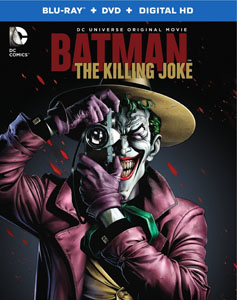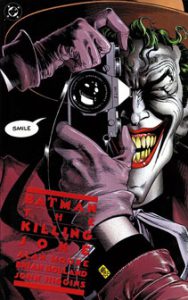This is part of a series where I look back at various works of “Batman” lore from the perspective of a heretofore casual “Batman” fan who enjoys the current TV series, “Gotham.”
Completing the holy trinity of Bat-comics, after “The Dark Knight Returns” and “Batman: Year One,” comes “The Killing Joke” (1988). While Frank Miller wrote the first two, another comics legend, Alan Moore, penned this one. I know him best from “V for Vendetta,” which came out concurrently with “The Killing Joke” (and which was beautifully adapted into a movie in 2006) and five odd-but-fascinating “Star Wars: Devilworlds” tales.
Stirring a debate
A graphic novel the length of two standard comics, this essential tale of Batman’s arch-nemesis is shorter than the other two classics, but it has generated perhaps even more discussion, springing from two questions: 1) Is Joker’s origin story, as presented here, accurate? And 2) Did Batman kill the Joker on the final page?

It’s fun to go down the rabbit hole of the web to explore different theories, but my first impression is that the answer to both questions is “no.”
Artist Brian Bolland’s colors – which for the 2008 deluxe edition replaced John Higgins’ original, more rushed colors – present clues that Joker’s origin story is not accurate. Bolland highlights dream-world details in red amid otherwise sepia-toned panels – details that are odd even within the context of Gotham.
Joker’s wife has a bowl of tentacles on the kitchen table; the thieves who hire Joker are eating bugs in a bar, which features people barfing, slumped over tables or grinning maniacally in the background; the thieves make Joker wear a Red Hood for no good reason; the idea that they need Joker to lead them through an industrial plant to a playing-card factory is illogical; it’s unlikely that the police would know where to find Joker to report his wife’s death; and the wife’s electrocution-by-baby-bottle-heater demise is itself bizarre.
Not the definitive story
It’s safe to say that this is not the definitive Joker origin story. Indeed, Joker himself says “Sometimes I remember it one way, sometimes another.” I think there is a kernel of truth to it, though. While this might not be how Joker’s “one bad day” unfolded in reality, it’s psychologically true in his mind. His true, without-a-doubt origin story has never been told in 75-plus years of Batman comics, which is rather appropriate for this character.
(“Gotham” is in the process of sort of telling a Joker origin story, although it is focusing more on the way proto-Joker Jerome Valeska’s outlook has infected other Gothamites, leading to a cult of the Joker – amid which Jerome returned to life in Monday’s episode, and from which the “real” Joker might spring forth.)

One thing that is clarified in “The Killing Joke,” for me at least, is that Joker does not wear face paint like a clown. Batman discovers Joker’s imposter in Arkham Asylum by noticing he is painted white. Joker’s skin actually is white, which again suggests a nugget of truth to the backstory, where he is deformed by falling into a vat of chemicals (which, before “Batman & Robin,” wasn’t quite as much of a cliché).
The question of whether Batman killed the Joker is an odd debate. He obviously didn’t, because Joker appeared in “Batman” comics after this. While some have contended that “Killing Joke” is an Elseworlds story (i.e., outside of the official continuity, like “Dark Knight Returns”), that theory falls apart due to the fact that it includes a central point of the lore: Joker shoots and paralyzes Barbara Gordon, marking her transition from Batgirl to Oracle. (In the TV show “Birds of Prey,” Barbara is paralyzed when she’s thrown into a support column during a fight between Batman and Joker.)
That’s not to say the final page, taken in and of itself, is clear. Moore and Bolland intended it to be ambiguous. Batman laughs at the Joker’s joke, then he reaches for his nemesis, whose laughter stops. Meanwhile, the headlight beams from the approaching police cars are turned off; this links to Joker’s joke about a man who would walk across a flashlight beam between rooftops, but he’ll fall to his death if the beam is turned off.
An ambiguous ending
I am a fan of some ambiguous endings. I think the end of “Last Man Standing: A Tale of Boba Fett” in “Star Wars: Tales of the Bounty Hunters” (1996) is brilliant: Han and Fett point guns at each other and debate whether to let fly (likely getting them both killed), or just walk away. “The Killing Joke” is similar. From the beginning, Batman is hoping there’s a way that his conflict with the Joker can end without death on either side. Joker, in an affecting panel, gives a rare straight answer: “No. I’m sorry, but … No. It’s too late for that. Far too late.”
I didn’t like this one quite as much, because I’m imagining how much more impactful it would be if we heard a “crack” of Batman breaking Joker’s neck, or alternatively, saw a panel of Batman handing Joker off to the police, so he can be returned to Arkham and/or charged with his new crimes.
The latter is what has to have happened in order to allow for future Joker stories, but it would’ve been nice to see that illustrated in light of Gordon’s order that Batman do this “by the book” – despite the fact that Joker shot his daughter, took nude pictures of her, stripped Gordon naked and put him on a roller coaster, and made Gordon look at the pictures.
It’s a fine line to walk, but “Last Man Standing” made me think “Wow, that’s a cool ending,” whereas “The Killing Joke” made me want to see more pages – not only the scene of Batman arresting Joker, but also perhaps an epilogue with Gordon, Barbara and Bruce. (It’s a good character-based cliffhanger, though, because “The Killing Joke” does make me want to check in on Barbara in her early Oracle days.)
Even though those pages write themselves – which is perhaps why Moore opted for a more artistic ending – I think it would’ve been satisfying to see them.

A look at the animated film
Interestingly, “The Killing Joke” gained another layer of controversy when it was adapted into an animated movie last year. In order to pad out the running time, it includes a prologue focusing on Barbara Gordon. As far as I can tell from a perusal of the web, this prologue does not come from the comics. Part of the purpose – and joy – of these DC adaptations is that they are faithful to the source material. If they blatantly diverted from that principle, I can understand the complaints.
Moore and Bolland’s book, though, stands as a classic examination of the gap that separates Batman and the Joker. We’re shown how similar they are (Bruce, of course, was changed by “one bad day” just like the Joker was), but we’re ultimately shown the key difference: The Joker wants Batman to cut loose and be as crazy as he is, but Batman won’t take the bait. That’s the gap that separates a hero from a villain.

